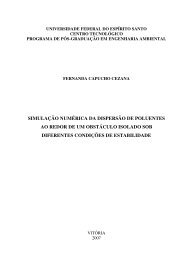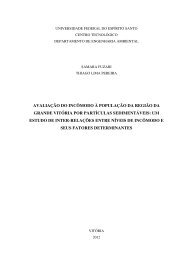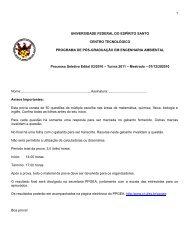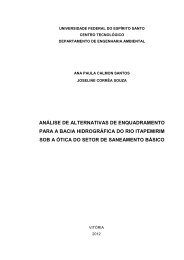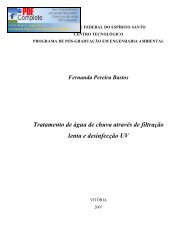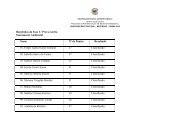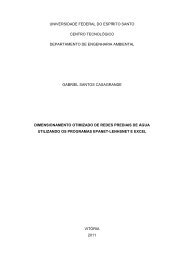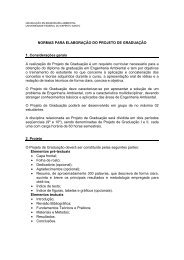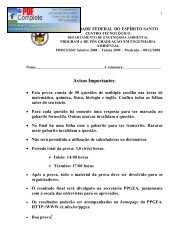Recuperação e Tratamento da Urina Humana Para Uso AgrÃcola
Recuperação e Tratamento da Urina Humana Para Uso AgrÃcola
Recuperação e Tratamento da Urina Humana Para Uso AgrÃcola
Create successful ePaper yourself
Turn your PDF publications into a flip-book with our unique Google optimized e-Paper software.
AbstractThe recycle of nutrients between the urban and cultivating areas, is a criticalstage in direction to the sustainable ecological development. Most of the nutrientsthat are essential in agriculture (N, P, K) is founded in human urine and, mostly, itstotal amount is more appropriate than the found ones in artificial fertilizers. Thepurpose of the present work is the quali-quantitative characterization, the evaluationof the types of storage (open, closed and aerated) and the evaporation utilized astechnique of volume reduction and concentration of nutrients. For this, a stage ofcharacterization was carried out, with urine of men, women, aged and children. Theresults of the characterization, analyzing volume and concentration of nutrients, showthat the per capita urine production is around 1,23L/d for men, women and aged andin 0,7L/d for children, and, in all, the urine presents 7,5g/L of nitrogen, 0,5g/L ofphosphorus and 1,6g/L of potassium. Talking now about the storage types, the use inclosed reservoirs was the type most efficient in the biological and physical chemistrystabilization process, because there wasn’t ammonia volatilization loss, and alsothere wasn’t possible contaminations for influence of the external environment, andthe concentration of the nutrients in this type was more satisfactory. The levels ofthermo tolerant coliforms tended practically null in a period of 15 <strong>da</strong>ys and atambient temperature. The evaporation process consisted in the use of the solarenergy as only source of heat, and thus, occurring a volume reduction and anconcentration increase of the nutrients. The evaporation of urine human occurredusing fresh and storaged urine. The fresh urine was collected with the support of thegroup of research of the UFES and the storaged urine of a reservoir of 200L locatedin ETE - UFES. Two containers for each type of urine had been used, and in one ofthem was added concentrated sulfuric acid in order to minimize the loss ofammonia. The evaporation rate was 2,3 to 2,8L/m².d. As to the nutrients (N, P, K, Caand Mg), the final residue obtained, presents significant amounts concentrationsaround 91% of the concentrations of these nutrients in artificial fertilizers. Afterevaporation, the average was of 21 kg of residual material for 500 kg of liquid urine.So, conclude that is sufficiently interesting of the economic and technical point ofview to aim for the use of the evaporation process.



